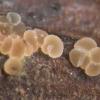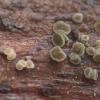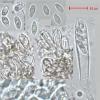
16-11-2025 21:09
 Robin Isaksson
Robin Isaksson
Anyone recognize this acc. to pictures.? Found on

14-11-2025 16:26
 Marian Jagers
Marian Jagers
Hello everyone, On dead wood of Cytisus scoparius

15-11-2025 23:22
Mario FilippaHello,this is what I think to be Hymenoscyphus mac

15-11-2025 20:25
 Riet van Oosten
Riet van Oosten
Hello, Found by Laurens van der Linde, Nov. 2025

14-11-2025 18:31
 Lothar Krieglsteiner
Lothar Krieglsteiner
Hello,can somebody provide me with a file of:Rothe

12-11-2025 09:25
 Viktorie Halasu
Viktorie Halasu
Hello, I need help with a pale terrestric Pseudom

11-11-2025 20:16
Bohan JiaHi, lastly I have found these tiny yellow decayin

09-11-2025 13:20
Hello.A tiny ascomycete, appearing as erupting gra
Hyphodiscus or Cistella?
Uwe Lindemann,
14-11-2009 01:37
I recently found a little discomycet which I can't determine.
Macroscopic features:
Apothecia gregarious, sessile; Disc 0,1-0,3 mm, young pale beige, old greyish and brownish with a greenish tint (see photos)
Microscopic features:
Asci arising from croziers, 8spored, 45-55 x 6-7 µm, mostly biserate, IKI- and MLZ- !
Spores ellipsoid, hyaline, aseptate, with two polar guttules and/or some small guttules, 6-7,3(9) x 2,7-3(3,5) µm
Paraphyses filiform, 2 µm wide, sometimes slightly thickened at the apex
Hairs hyaline, thin to thick walled, coarsely warted, up to 5 µm wide; in some areas of the excipulum they are yellowish caused by a yellowish "exudate" which covered the outside of the excipulum.
Ectale excipulum: textura prismatica, mostly getalinous
It grows on Rubus.
My first guess is Hyphodiscus hymeniophilus but the size of the spores and the substrate are not fitting well.
What do you think about it? I would be very happy if you can help me!
Best Uwe
Hans-Otto Baral,
14-11-2009 10:05

Re:Hyphodiscus or Cistella?
Hi Uwe
this is 100% a Hyphodiscus, because of brownish colour and yellow exudate (which is onoly inconsistently present in Hyphodiscus but never in Cistella). The strongly gelatinized excipulum is also typica.
I would also say H. hymeniophilus, spore size , shape and gutules would fit quite well. But if you are right that the asci are inamyloid (in Lugol) then this would be the first time. I suggest you try pretretment with KOH and then test IKI or MLZ again. Hyphodisci are often hemiamyloid, so a clear blue is only obtained after KOH, and the IKI-red reaction sometimes overlooked.
My only collection with sch elongate spores and inamyloid asci was on Alnus viridis. Regrettably it was in bad shape, so I had no free spores:
H. cf. hymeniophilus. Asci IKI-/K+IKI-. Sp. *5-6(-8) x 2-2.2 µm, Ölm.1: 2-3 minute LBs in each end.
Was it Rubus idaeus or fruticosus-group?
Zotto
this is 100% a Hyphodiscus, because of brownish colour and yellow exudate (which is onoly inconsistently present in Hyphodiscus but never in Cistella). The strongly gelatinized excipulum is also typica.
I would also say H. hymeniophilus, spore size , shape and gutules would fit quite well. But if you are right that the asci are inamyloid (in Lugol) then this would be the first time. I suggest you try pretretment with KOH and then test IKI or MLZ again. Hyphodisci are often hemiamyloid, so a clear blue is only obtained after KOH, and the IKI-red reaction sometimes overlooked.
My only collection with sch elongate spores and inamyloid asci was on Alnus viridis. Regrettably it was in bad shape, so I had no free spores:
H. cf. hymeniophilus. Asci IKI-/K+IKI-. Sp. *5-6(-8) x 2-2.2 µm, Ölm.1: 2-3 minute LBs in each end.
Was it Rubus idaeus or fruticosus-group?
Zotto
Uwe Lindemann,
14-11-2009 11:02
Re:Hyphodiscus or Cistella?
Hi Zotto,
yes, the porus is hemiamyloid! After the pretreatment with KOH I can see the IKI-reaction (blue) very well. Thank you for your help!
An the substrate is of the rubus fruticosus-group (Brombeere).
All my best,
Uwe
yes, the porus is hemiamyloid! After the pretreatment with KOH I can see the IKI-reaction (blue) very well. Thank you for your help!
An the substrate is of the rubus fruticosus-group (Brombeere).
All my best,
Uwe



